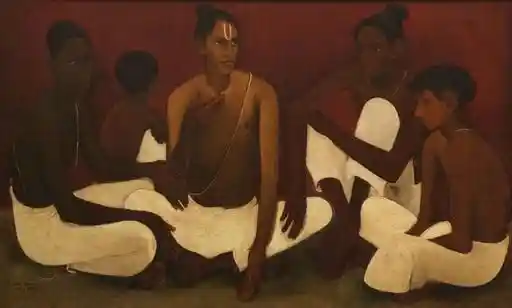Amrita Sher-Gil: The Indian Frida Kahlo
One of the most gifted female artists of Modern India, Amrita Sher-Gil’s paintings go beyond mere aesthetics. They are slices of real life, enhanced and dramatized with the strokes of her paintbrush. Let's take a look at the life and style of India's 'Frida Kahlo'.

(Amrita Sher-Gil at her studio; Image source - tallengestore.com)
Born in Budapest on January 30, 1913, to an Indian Sikh father, Umrao Singh Sher-Gil, a Sanskrit scholar, and a Hungarian mother, Maria Antoinette, an opera singer, Amrita Sher-Gil was rarely acknowledged in her short lifetime. Despite learning a Realist and academic style of painting from Paris, she found herself drifting towards the colours and rich lighting of the East and drew inspiration from the lives of the common people in India.
Sher-Gil wrote, “I realized my real artistic mission, to interpret the life of Indians and particularly the poor Indians pictorially; to paint those silent images of infinite submission and patience... to reproduce on canvas the impression those sad eyes created on me.”
She was heavily influenced by wall paintings in Western India and the aesthetic of European oil painting techniques. This blend of western techniques and traditional inspirations made her paintings vibrant and colourful. Sher-Gil was able to achieve special effects with colours that were unbridled and bold, in direct contrast to the pale hues in vogue among her contemporaries. Her style stood out from those of Abanindranath Tagore, Abdur Rahman Chughtai, and Nandalal Bose—who belonged to the Bengal school.
‘I began to be haunted by an intense longing to return to India’, Sher-Gil wrote, ‘feeling in some strange, inexplicable way that there lay my destiny as a painter.’ Longing to get back to her roots, she returned to India in 1934 which marked a new phase in her art journey. In 1937, she set out on a journey to South India, and this became the inspiration behind the "South Indian trilogy” (Brahmacharis, South Indian Villagers Going to Market, and Bride’s Toilet).
The paintings of Ajanta and Ellora had an everlasting impact on Sher-Gil. She felt a strong empathy for her Indian subjects, depicting the poverty which blighted much of her country. She engaged with the rhythms of rural life in India which were in contrast to her own life as a woman who came from an affluent and upper-middle-class family.
However, the young artist Sher-Gil, at the brink of her first major solo exhibition, suddenly died at the age of 28, depriving the realm of Indian art of a true icon for centuries to come. She had carved a path for herself that none could emulate without reverence. Even today, her legacy lives on and continues to inspire artists with her unique and captivating paintings.
Self-portraits and south Indian themes were a favourite of the artist. Her work, Group of Three Girls, won the Gold Medal at the annual exhibition of the Bombay Art Society. Notably, Sher-Gil's art was strongly influenced by the paintings of Rabindranath and Abanindranath Tagore, who were pioneers of the Bengal School of painting. Her range in experimentation and uniqueness of style can be amply seen in Village Scene, In the Ladies' Enclosure, and Siesta, all of which portray the life of rural Indians. “Siesta and In the Ladies' Enclosure reflect her experimentation with the miniature school of painting while Village Scene reflects influences of the Pahari school of painting”. As an iconoclastic person and artist, Sher-Gil’s life was characterized by choices at times too zestful for the age she lived in. She was a free spirit, and it reflected in her bold choices in sexuality - it was believed that she painted Two Women representing herself and her lover Marie Louise.

(Two Women; Source: Google Arts and Culture)

(Brahmacharis by Amrita Sher-Gil is one of her finest paintings done in 1937; Image Source - Abirpothi.com)


